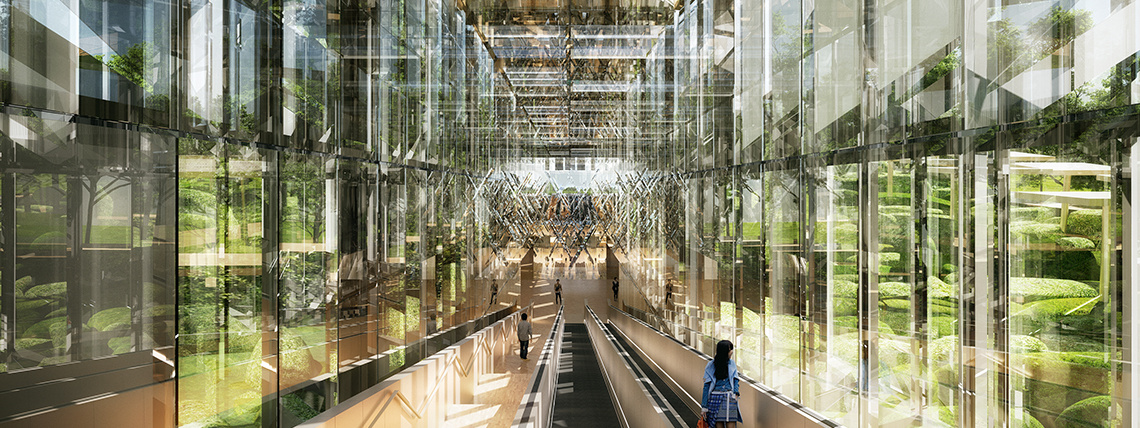The articles of the current edition are available on the new site.

The world’s most visited architecture event, the Bi-City Biennale of Urbanism\Architecture of Hong Kong and Shenzhen (UABB), will open on December 21, 2019 in the city of Shenzhen, China. The “Eyes of the City” section, curated by MIT professor Carlo Ratti (Chief Curator), Politecnico di Torino and the South China University of Technology (SCUT, Academic Curators), has been conceived for full digital fabrication – both locally and through a global network of Fab Labs, in collaboration with the Fab Foundation. The exhibition aims to engage a global audience in a critical discussion on the impact of A.I. and new technologies on cities. It will incorporate a facial recognition platform on its own premises, and advocate for the right to opt out from the system “Eyes of the City” will remain open until March 2020 and will feature a series of talks with international speakers, fostering knowledge exchange.
All installations in the “Eyes of the City” section were produced locally and assembled on-site, without resorting to international shipping. Such stance is both a tribute to Shenzhen’s role as “factory of the world” and a way to push the boundaries of digital fabrication. For each project, exhibitors provided a series of blueprints to instruct Shenzhen-based manufacturers on how to build the exhibits. The blueprints will be made available online, in an open source way, in sync with the opening of the exhibition, to allow people to download them and replicate or further develop specific projects and tools.
To push the conversation further, “Eyes of the City” has announced a partnership with the Fab Foundation, representing the world’s largest network of Fab Labs, to ensure people who are not able to join the debate in Shenzhen can continue the discussion prompted by the exhibition by interacting with the varied network of Fab Labs across the world – including HK (Openground), Shenzhen (SZOIL), Seoul, San Francisco, Boston and Lima. Individual Fab Labs could come together and experiment with ideas and projects that were first introduced in Shenzhen, enhancing their scalability or simply reinterpreting them based on their local context.
“’Eyes of the City’ was inspired by Jane Jacobs’s ‘eyes on the street’ idea, which put people back at the heart of city-making, and reflects on what happens when the urban landscape itself acquires the ability to observe us. At a time when urban technologies are under scrutiny across the world, ‘Eyes of the City’ aims to spark conversations and build links far beyond Shenzhen,” says Carlo Ratti, director of the Senseable City Lab at the Massachusetts Institute of Technology and founder of CRA design practice: “The networked, open-source approach was conceived to encourage a critical exchange across boundaries. We are excited to collaborate with the Fab Foundation towards this objective.”
The “Eyes of the City” features more than 60 exhibits from all around the world, mostly selected through an open call for design projects, research projects and papers that received more than 280 applications from around the world (the full list of invited exhibitors is available here and below). The main themes explored as part of “Eyes of the City” have also inspired a series of talks and panels that will bring more than 80 international and local speakers to Shenzhen to continue the conversation. The opening weekend will include book conferences and seminars on design and practice, the future of heritage and architecture in South China. Events will take place in the Shenzhen Museum of Contemporary Art and Urban Planning (MOCAUP) (more details here and below).
“‘Eyes of the City’ explores the crucial role that technology is destined to play in our everyday urban life. Our tech-enhanced cities could become spaces that improve people’s well-being, but they could also turn into a dystopia. An open conversation and exchange of knowledge could be antidotes to this. UABB’s 8th edition is the first Biennale to include universities in its curatorial team: this was crucial to assure an open exchange of knowledge at the very base of the curatorial process. We set up a platform for debate, which is also why we organized a series of marathon talks with authoritative guests and scholars” says Michele Bonino, Rector’s Delegate for Relations with China at Politecnico di Torino.
The exhibition will extend over a surface of more than 5,000 square meters, reacting to its transportation-hub location with a unique design, inspired by duty-free shopping areas. The creative spatial layout was developed by CRA and Politecnico di Torino, while the visual language was conceived by the Dutch graphic designer Mieke Gerritzen. The location and its design also become tools to engage a wider audience of visitors and passersby in order to spark an inclusive conversation.
Focusing on various technologies and their impact on everyday life and design practices, “Eyes of the City” will be the first exhibition to include facial recognition in its own premises. The exhibition can be accessed through two info points, designed by leading Dutch practice MVRDV with the support of The Cooper Union, that incorporate facial recognition technology yet give people the possibility to preserve their anonymity by wearing an “opt-out” sticker and knowing camera locations in advance thanks to explicit wayfinding. The space is divided into eight sections, each of them tackling a different aspect of the impact of technology on cities: World’s Urban Lab, Mobility Landscapes, Silicon Pupils, Digital Society, Design Intelligence, Artificial Ecologies, Resisting technologies, Curating the City.
All materials, blueprints, information and calendar of public events will become accessible on www.eyesofthecity.net from December 22nd 2019, and will be updated throughout the duration of the Biennale.